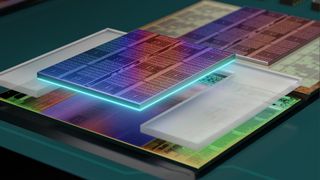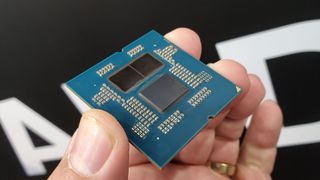AMD is 'working actively on really cool differentiators' to make the next generation of 3D V-cache 'even better'
X3D versions of Ryzen 9000-series chips won't be announced for a good while, though.

PC enthusiasts know that if you want the best gaming CPU, then you really can't go wrong with the Ryzen 7 7800X3D. Its mighty gaming chops are helped in no small way by the additional 64MB of 3D V-cache, so when AMD announced its new Zen 5 architecture, many hoped there would be some info on Ryzen 9000X3D models. That never happened, but AMD did tell us that it's "working actively on really cool differentiators" to make 3D V-cache "even better."
While at Computex 2024 in Taiwan, we chatted for a while with Donny Woligroski, AMD's senior technical marketing manager. When we got around to talking about plans for 3D V-cache versions of Zen 5 chips, he was especially enthusiastic about the technology.
"The X3D stuff, we have a lot to say about it. The best part about it is we're not just resting on laurels. We're improving what we can do with X3D, it's really exciting and I'm super looking forward to talking to people about that."
Woligroski couldn't go into any specifics, but he did continue talking about what AMD is doing regarding 3D V-cache. "It's not like, hey, we've also added X3D to a chip. We are working actively on really cool differentiators to make it even better. We're working on X3D, we're improving it."
While that might all sound like bluster about nothing, one can't expect AMD to say "Nah, we'll just use the same stuff as last time" or anything like that. At least, it's said that it's working on making it better. The obvious questions to ask are what could those differentiators be and how can the current 3D V-cache be made better?
One possible answer to the first question is that AMD could be working on implementing different sizes of 3D V-cache, to increase the level of differentiation between the various X3D models. At the moment, no matter whether it's a Ryzen 5 5600X3D, Ryzen 9 7950X3D, or an EPYC 9684X with 1GB of L3 cache, the 3D V-cache slice is always 64MB in size.
A product in which V-cache is notably missing is AMD's APUs, like the Ryzen 8040U and the new Ryzen AI 300 series. These processors sport a decent integrated GPU, but its performance is somewhat hamstrung by the relative lack of memory bandwidth. Having an extra level of cache between the GPU and VRAM would greatly help here, as demonstrated by RDNA 2 and RDNA 3 graphics cards.
The biggest gaming news, reviews and hardware deals
Keep up to date with the most important stories and the best deals, as picked by the PC Gamer team.

Or it might be a case that AMD is considering bonding smaller L3 slices to lower-tier Ryzen X3D chips, just to make the Ryzen 9 versions stand out even more.
But how to make it better, in general? Well, in Ryzen and EPYC CPUs, the additional slice of L3 cache is bonded to the surface of one or more CCDs (Core Complex Dies). Not only do the extra transistors in this cache increase the power consumption, but they also increase the thermal resistance of the whole chip, forcing AMD to reduce the boost clocks on X3D versions of the regular CPUs.
The first generation of 3D V-cache, used on Zen 3 processors, is roughly 41 square millimetres in area and AMD managed to shrink this a little, to 36 square millimetres, for Zen 4. Both SRAM chiplets are fabricated by TSMC on its N7 process node and although SRAM doesn't scale very well on smaller nodes, AMD may choose to use N5 for the third generation.

Catch up with Computex 2024: We're on the ground at Taiwan's biggest tech show to see what Nvidia, AMD, Intel, Asus, Gigabyte, MSI and more have to show.
Doing so could potentially allow for a greater amount of cache to be stuffed into the same area or possibly still have 64MB but in a thinner die. That would trap less heat, meaning the boost clocks could be set a little higher than normal.
Whatever AMD has up its sleeves for the third generation of 3D V-cache, we probably won't hear anything about Ryzen X3D models until much later in the year. Zen 4 was first announced in August 2022 and the first X3D model, the Ryzen 9 7950X3D, made an appearance almost six months later, in February 2023.
If one assumes that Zen 5 will follow a similar timeline, then the first Ryzen 9000X3D chips should be available towards the very end of this year. There again, Zen 5 was announced a little earlier than expected, so you never know, the Ryzen 7 9800X3D could be on sale by fall and that would be something to really look forward to.

Nick, gaming, and computers all first met in 1981, with the love affair starting on a Sinclair ZX81 in kit form and a book on ZX Basic. He ended up becoming a physics and IT teacher, but by the late 1990s decided it was time to cut his teeth writing for a long defunct UK tech site. He went on to do the same at Madonion, helping to write the help files for 3DMark and PCMark. After a short stint working at Beyond3D.com, Nick joined Futuremark (MadOnion rebranded) full-time, as editor-in-chief for its gaming and hardware section, YouGamers. After the site shutdown, he became an engineering and computing lecturer for many years, but missed the writing bug. Cue four years at TechSpot.com and over 100 long articles on anything and everything. He freely admits to being far too obsessed with GPUs and open world grindy RPGs, but who isn't these days?
Most Popular







